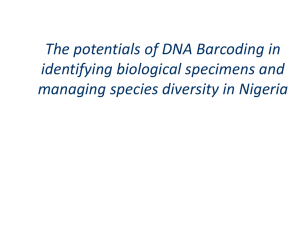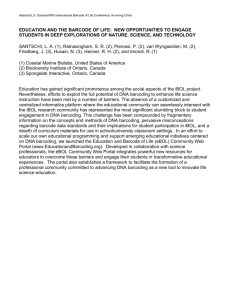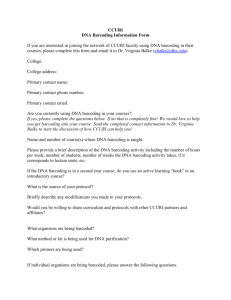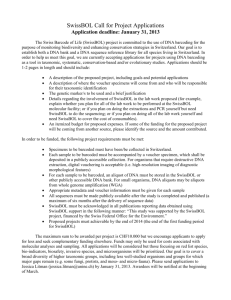Secondary Activities for DNA Barcoding at the Toronto Zoo Name
advertisement
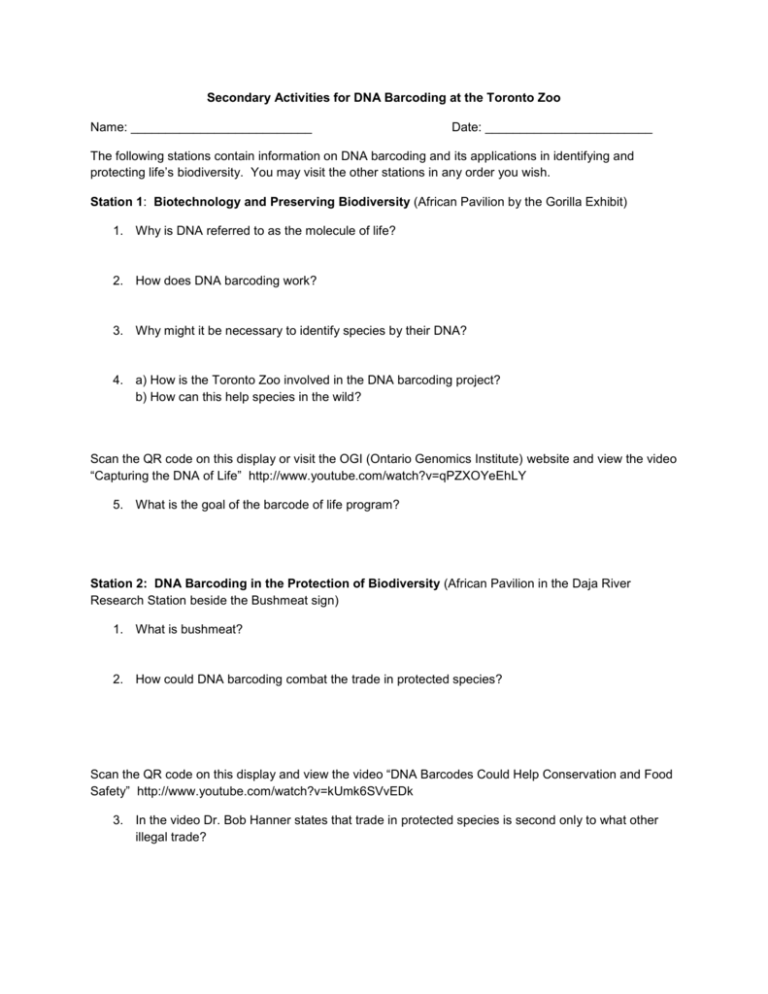
Secondary Activities for DNA Barcoding at the Toronto Zoo Name: __________________________ Date: ________________________ The following stations contain information on DNA barcoding and its applications in identifying and protecting life’s biodiversity. You may visit the other stations in any order you wish. Station 1: Biotechnology and Preserving Biodiversity (African Pavilion by the Gorilla Exhibit) 1. Why is DNA referred to as the molecule of life? 2. How does DNA barcoding work? 3. Why might it be necessary to identify species by their DNA? 4. a) How is the Toronto Zoo involved in the DNA barcoding project? b) How can this help species in the wild? Scan the QR code on this display or visit the OGI (Ontario Genomics Institute) website and view the video “Capturing the DNA of Life” http://www.youtube.com/watch?v=qPZXOYeEhLY 5. What is the goal of the barcode of life program? Station 2: DNA Barcoding in the Protection of Biodiversity (African Pavilion in the Daja River Research Station beside the Bushmeat sign) 1. What is bushmeat? 2. How could DNA barcoding combat the trade in protected species? Scan the QR code on this display and view the video “DNA Barcodes Could Help Conservation and Food Safety” http://www.youtube.com/watch?v=kUmk6SVvEDk 3. In the video Dr. Bob Hanner states that trade in protected species is second only to what other illegal trade? Station 3: A Fishy Tail (Beside the Lake Victoria cichlids in the African Pavilion) 1. How can fish species be identified once their scales have been removed? 2. What percentage of fish fillets were found to be mislabeled? 3. Describe two possible implications of mislabeling fillets. Station 4: Whooos in the Rouge? (Indomalaya Pavilion by the Samatran Orangutans on the glass windows overlooking the forested area) Scan the QR code on the display or visit the website: “Barcode of Life: Global Biodiversity Challenge” http://www.youtube.com/watch?v=HU1ru9H332s 1. What percentage of the earth’s species are believed to be unidentified? 2. What are invasive species and what impacts can they have on the environment? 3. What are the advantages of faster identification of invasive species using DNA barcodes? 4. What is a BioBlitz and why are they conducted? Additional Questions Visit the Ontario Genomics Institute’s website: Why genomics: Making every species count http://www.whygenomics.ca/making-every-species-count 1. Describe two other applications of DNA barcoding described on this website that were not covered by the signs at the zoo. 2. DNA barcoding has also been used to identify the species of bird after a ‘bird strike’ on an airplane engine. Why might this information be useful to the aviation industry? Research Project: At Risk Species Report Name: _________________________________ Date: __________________ During your visit to the Toronto Zoo observe an animal which is a member of an at-risk species (i.e. endangered, extirpated, threatened, etc.). Think about this animal and why it is important to protect it. Many individuals and organizations need to be a part of protecting the world’s biodiversity. DNA barcoding can be one important tool in this process. Research your animal and include answers to the following questions in your report: Communication: Description of species o o o o o General information and description of animal Taxonomy and scientific name of the species - Evolutionary history of animal and closely related species Reproduction and development of species Distribution and habitat of species Ecological Niche - Describe some of the roles your animal plays in its environment and some of its unique adaptations. Application: Cause of at risk status, reasons and ways to protect this species o o o o o o What is the at risk status of your animal; what factors have contributed to this status? - Include effects of human activity on species How has the decline of this species impacted the ecosystem, other species and humans? Could DNA barcoding potentially help protect this animal? Clearly explain your reasoning. - Other technologies or programs which could help this species (e.g. captive breeding programs) Clearly describe what is needed to protect this animal. Your answer should include efforts at several levels (E.g. individual, government, education, enforcement and other agencies) Organizations that work to conserve the species or its habitat. How can we help? Overview of your animal (Why it is an important species to protect). Include some of your personal views based on observation at the zoo. Communication: Relevant images and referencing in APA format Embedded references are required. All information is paraphrased o o o o Include at least three references for your assignment - Note: Visit www.torontozoo.com/exploretheZoo/Animals.asp and search the animals tab for information Embedded references are included Relevant images (properly reference in APA format) Well organized layout and visual appeal of report. Rough Notes for at Risk Species Report: Species selected (Note: everyone in your group must select a different species) Relevant information from signs at zoo Observations of the animal at the zoo Any insights on why this an important species to protect

